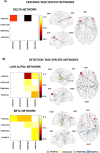Attention and speech-processing related functional brain networks activated in a multi-speaker environment
- PMID: 30818389
- PMCID: PMC6394951
- DOI: 10.1371/journal.pone.0212754
Attention and speech-processing related functional brain networks activated in a multi-speaker environment
Abstract
Human listeners can focus on one speech stream out of several concurrent ones. The present study aimed to assess the whole-brain functional networks underlying a) the process of focusing attention on a single speech stream vs. dividing attention between two streams and 2) speech processing on different time-scales and depth. Two spoken narratives were presented simultaneously while listeners were instructed to a) track and memorize the contents of a speech stream and b) detect the presence of numerals or syntactic violations in the same ("focused attended condition") or in the parallel stream ("divided attended condition"). Speech content tracking was found to be associated with stronger connectivity in lower frequency bands (delta band- 0,5-4 Hz), whereas the detection tasks were linked with networks operating in the faster alpha (8-10 Hz) and beta (13-30 Hz) bands. These results suggest that the oscillation frequencies of the dominant brain networks during speech processing may be related to the duration of the time window within which information is integrated. We also found that focusing attention on a single speaker compared to dividing attention between two concurrent speakers was predominantly associated with connections involving the frontal cortices in the delta (0.5-4 Hz), alpha (8-10 Hz), and beta bands (13-30 Hz), whereas dividing attention between two parallel speech streams was linked with stronger connectivity involving the parietal cortices in the delta and beta frequency bands. Overall, connections strengthened by focused attention may reflect control over information selection, whereas connections strengthened by divided attention may reflect the need for maintaining two streams in parallel and the related control processes necessary for performing the tasks.
Conflict of interest statement
The authors have declared that no competing interests exist.
Figures







References
-
- Cherry C. Some Experiments on the Recognition of Speech with One and with Two Ears.pdf.
-
- Bregman AS. Auditory Scene Analysis. of MIT CogNet. Chapter 1 The Auditory Scene. 1994;
-
- Hickok G, Poeppel D. processing. 2007;8: 393–402. - PubMed
Publication types
MeSH terms
LinkOut - more resources
Full Text Sources

